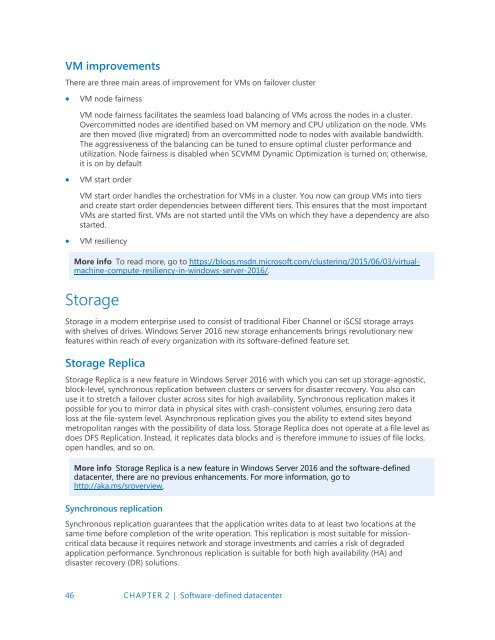Introducing
IntroducingWindowsServer2016_ebook
IntroducingWindowsServer2016_ebook
You also want an ePaper? Increase the reach of your titles
YUMPU automatically turns print PDFs into web optimized ePapers that Google loves.
VM improvements<br />
There are three main areas of improvement for VMs on failover cluster<br />
<br />
VM node fairness<br />
VM node fairness facilitates the seamless load balancing of VMs across the nodes in a cluster.<br />
Overcommitted nodes are identified based on VM memory and CPU utilization on the node. VMs<br />
are then moved (live migrated) from an overcommitted node to nodes with available bandwidth.<br />
The aggressiveness of the balancing can be tuned to ensure optimal cluster performance and<br />
utilization. Node fairness is disabled when SCVMM Dynamic Optimization is turned on; otherwise,<br />
it is on by default<br />
<br />
VM start order<br />
VM start order handles the orchestration for VMs in a cluster. You now can group VMs into tiers<br />
and create start order dependencies between different tiers. This ensures that the most important<br />
VMs are started first. VMs are not started until the VMs on which they have a dependency are also<br />
started.<br />
<br />
VM resiliency<br />
More info To read more, go to https://blogs.msdn.microsoft.com/clustering/2015/06/03/virtualmachine-compute-resiliency-in-windows-server-2016/.<br />
Storage<br />
Storage in a modern enterprise used to consist of traditional Fiber Channel or iSCSI storage arrays<br />
with shelves of drives. Windows Server 2016 new storage enhancements brings revolutionary new<br />
features within reach of every organization with its software-defined feature set.<br />
Storage Replica<br />
Storage Replica is a new feature in Windows Server 2016 with which you can set up storage-agnostic,<br />
block-level, synchronous replication between clusters or servers for disaster recovery. You also can<br />
use it to stretch a failover cluster across sites for high availability. Synchronous replication makes it<br />
possible for you to mirror data in physical sites with crash-consistent volumes, ensuring zero data<br />
loss at the file-system level. Asynchronous replication gives you the ability to extend sites beyond<br />
metropolitan ranges with the possibility of data loss. Storage Replica does not operate at a file level as<br />
does DFS Replication. Instead, it replicates data blocks and is therefore immune to issues of file locks,<br />
open handles, and so on.<br />
More info Storage Replica is a new feature in Windows Server 2016 and the software-defined<br />
datacenter, there are no previous enhancements. For more information, go to<br />
http://aka.ms/sroverview.<br />
Synchronous replication<br />
Synchronous replication guarantees that the application writes data to at least two locations at the<br />
same time before completion of the write operation. This replication is most suitable for missioncritical<br />
data because it requires network and storage investments and carries a risk of degraded<br />
application performance. Synchronous replication is suitable for both high availability (HA) and<br />
disaster recovery (DR) solutions.<br />
46 CHAPTER 2 | Software-defined datacenter


